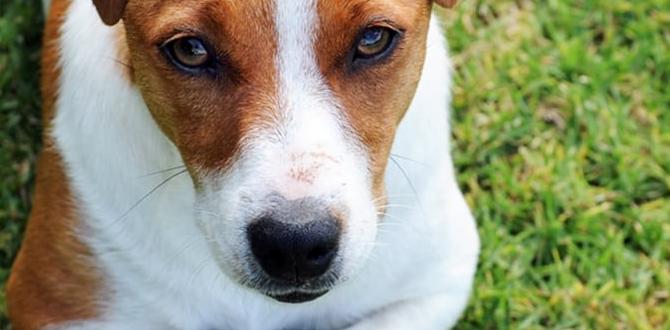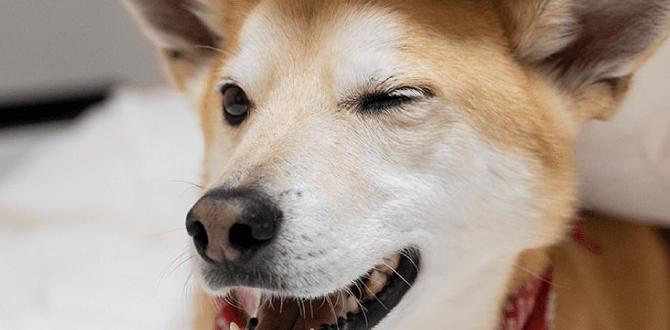Have you ever noticed your older dog acting strangely? Maybe they chase their tails or bark at nothing. These could be signs of compulsive dog behavior in older dogs. It can be worrying, but understanding it is the first step to helping. Let’s explore what this behavior means and how you can help your furry friend.
Key Takeaways
- Compulsive behaviors can be signs of stress or anxiety.
- Older dogs may develop these habits over time.
- Consult your vet if compulsive dog behavior in older dogs appears.
- Training and attention can reduce compulsive actions.
- Understanding triggers can help manage dog behavior.
Understanding Compulsive Behaviors
Compulsive behaviors in older dogs can seem odd. These actions are repeated often and seem to have no purpose. Dogs might chase their tails, lick the floor, or even snap at the air. Many times, these behaviors start because of stress or anxiety. In older dogs, it can also come from changes in their environment or routine. These behaviors become a way to cope, even if they don’t make sense to us. Observing when and why these behaviors start is key to understanding them.
- Compulsive tail chasing
- Excessive licking or scratching
- Barking at nothing
- Pacing back and forth
- Repetitive head shaking
Identifying these behaviors early can help you find solutions. Different dogs may show different compulsive actions. The first step is to see what might trigger these actions. Is it a loud noise? Or maybe being left alone too long? Finding the cause can lead to the right help for your dog.
Fun Fact or Stats : Dogs can have OCD-like behaviors, just like humans!
Common Triggers for Compulsive Actions
What makes a dog start a compulsive behavior? Sometimes, it can be stress. Perhaps a loud noise, like thunder, scares them. Or maybe they don’t like being alone. Anxiety is another trigger. If they feel unsure or scared, they might start to act compulsively. Changes in their routine can also be a big trigger. A move to a new house or a new pet can upset their balance. Knowing what triggers your dog can help you manage their behavior better.
The Connection Between Age and Behavior
As dogs grow older, they experience changes just like humans do. Their senses might not be as sharp, or they might not move as quickly. This can lead to frustration or confusion. It can also mean they have less energy to cope with stress. Older dogs might become more prone to compulsive behaviors. Understanding this connection helps you provide the right care. It can make a world of difference for your loyal companion.
When to Seek Professional Help
Not sure if you need a vet’s help? If your dog’s behavior changes suddenly or severely, it’s time to call a vet. They can rule out any medical issues. Sometimes, compulsive behavior in older dogs can signal health problems. A vet can help you understand what’s happening. They might suggest training, medication, or changes at home. Don’t hesitate to reach out if you’re worried. Your vet is there to help keep your dog happy and healthy.
How to Help Your Older Dog
Helping a dog with compulsive behavior can take patience. Start by observing their actions. What happens before they act compulsively? This can give clues about triggers. Provide a calm environment to reduce stress. Toys and puzzles can keep their mind busy. Regular exercise is also important. A tired dog is often a happy dog. Training sessions can be a fun way to bond and redirect their energy.
- Identify behavior triggers
- Provide mental stimulation
- Maintain a stable routine
- Use positive reinforcement
- Consult a professional trainer
Consistency is key. Stick to a routine and positive reinforcement. If needed, ask a professional for help. They can offer new strategies or training techniques. Remember, every dog is unique. What works for one might not work for another. Your efforts can make a big difference to your dog’s happiness.
Fun Fact or Stats : Dogs love routines! It makes them feel safe and secure.
Creating a Calming Environment
How can you make your home more calming for your dog? A quiet, comfortable space is a great start. Make sure they have a cozy bed and some favorite toys. Try to keep noise levels down, especially if your dog is sensitive to sounds. Some dogs enjoy soft music or white noise. It can help mask scary sounds outside. You can also try calming sprays or diffusers. These release dog-friendly scents that can help soothe them.
Importance of Regular Exercise
Why is exercise so important for dogs? Just like people, dogs have energy they need to burn. Regular exercise can prevent boredom and reduce anxiety. Walks, runs, and playtime are all great ways to keep your dog active. Choose activities that suit your dog’s age and ability. Older dogs might enjoy short, gentle walks. Consistent physical activity can lead to a happier and healthier dog. It can also reduce compulsive behaviors.
Training Techniques That Help
Training can be a fun way to help your dog. Positive reinforcement is a great tool. Reward good behavior with treats or praise. Redirect compulsive actions by offering a toy or asking for a trick. Be patient and consistent. Training can strengthen your bond and improve behavior. It can also be a chance for your dog to learn new skills. Consider professional training if you’re struggling. Trainers have the knowledge to help tackle difficult behaviors.
Understanding Medical Causes
Sometimes, compulsive behavior in older dogs has medical roots. Conditions like arthritis can cause discomfort. This may lead to excessive licking or pacing. Other health issues, like cognitive decline, can also play a part. If you notice changes in your dog’s behavior, a vet visit is a good idea. The vet can check for underlying health issues. They might suggest treatments or medications that can help your dog feel better.
- Arthritis causing discomfort
- Cognitive decline affecting behavior
- Medical check-ups help identify issues
- Treatment options can reduce compulsive actions
- Vet advice is crucial for care
Understanding the medical side is important. It helps you provide the best care for your dog. If a health issue is causing the behavior, treating it can make a big difference. Don’t forget to schedule regular check-ups for your pet. Your vet can offer guidance and support along the way.
Fun Fact or Stats : Regular vet visits can extend your dog’s life by a year or more!
Common Medical Conditions in Older Dogs
As dogs age, they can develop health issues. Arthritis is common and can make movement painful. Cognitive decline is another concern. It can affect their memory and behavior. Dental problems can lead to discomfort and changes in eating habits. Regular vet visits can help catch these issues early. Don’t wait until there’s a problem. Preventative care is key. It ensures your dog stays happy and healthy longer.
How a Vet Can Help
What can a vet do for your dog? They can diagnose health issues that may cause compulsive behavior. A vet can suggest treatments, like medication or therapy. They can also offer nutritional advice. If your dog has a condition like arthritis, a vet can prescribe pain relief. Regular vet visits ensure your dog gets the care they need. Don’t hesitate to reach out to a vet if you have concerns. They are there to help and support you and your pet.
Choosing the Right Treatment
Finding the right treatment for your dog can take time. Your vet can help guide you. They might suggest medications to reduce anxiety or pain. Therapy, like physical therapy, can help with mobility issues. Dietary changes can also support your dog’s health. Always follow your vet’s recommendations. They have the expertise to find the best solution for your pet. Treatment can improve quality of life and reduce compulsive behaviors.
Recognizing Anxiety and Stress Triggers
Anxiety and stress can cause compulsive behaviors in dogs. Recognizing these triggers is important for management. Loud noises, like fireworks, can spark anxiety. Changes in routine or environment can also be stressful. Some dogs don’t like being alone and may act out when left. Identifying what makes your dog anxious is the first step. It allows you to create strategies to reduce stress and manage behavior.
- Loud noises like fireworks or thunder
- Changes in routine or environment
- Separation anxiety from being alone
- Identify triggers to manage stress
- Create strategies for calming
Helping your dog cope with stress can involve different techniques. A quiet, safe space can provide comfort. Toys or puzzles can distract from stressors. Consistent routines help provide stability. Training and positive reinforcement can also reduce anxiety. Work with your dog to find what helps them feel calm and secure.
Fun Fact or Stats : Dogs can detect emotions in their human companions!
Environmental Changes That Cause Stress
Have you ever moved to a new home? It’s a big change, and it can be stressful. Dogs feel the same way. Moving to a new environment can cause anxiety in dogs. New smells, sounds, and spaces can be overwhelming. Changes in routine, like a new family member, can also be stressful. Recognizing these changes helps you support your dog. Gradual introductions and consistent routines can ease the transition.
Managing Separation Anxiety
Some dogs don’t like being alone. They might bark, chew, or pace when left. This is called separation anxiety. Helping dogs cope with this anxiety takes time. Start by leaving them for short periods. Gradually increase the time away. Keep departures and arrivals calm. Provide toys to keep them busy. Training can also help, like teaching a “stay” command. With patience and consistency, you can help reduce their anxiety.
Using Soothing Techniques
How can you soothe an anxious dog? Try using calming music or white noise. It can drown out scary sounds. Dog-friendly pheromone sprays or diffusers can also help. These products release scents that calm dogs. Providing a safe space, like a crate, can offer comfort. Make sure it’s cozy with a bed and toys. Remember, the goal is to create a calm environment. It’s all about finding what works best for your dog.
Conclusion
Compulsive dog behavior in older dogs can be challenging. Understanding these behaviors is the first step in helping. With patience, care, and the right strategies, you can improve your dog’s quality of life. Don’t hesitate to seek professional help if needed. Your dog relies on you, and together, you can face any challenge.
FAQs
Question: What causes compulsive dog behavior in older dogs?
Answer: Compulsive dog behavior in older dogs can result from stress, anxiety, or medical issues. Changes in routine or environment can trigger these actions. It’s important to identify triggers and manage them effectively.
Question: How can I help my dog with compulsive behaviors?
Answer: Provide a calm environment, use positive reinforcement, and consult a vet. Toys and mental stimulation can help distract your dog from compulsive actions. Professional training may also be beneficial.
Question: When should I see a vet for my dog’s behavior?
Answer: See a vet if the behavior changes suddenly or is severe. A vet can rule out medical issues and suggest treatments. It’s always better to be safe and consult a professional.
Question: Are some dog breeds more prone to compulsive behaviors?
Answer: Yes, some breeds are prone to compulsive behaviors. This includes breeds with high energy or intelligence. However, any dog can develop these behaviors under the right conditions.
Question: Can compulsive behavior in older dogs be cured?
Answer: While it may not be cured, it can be managed. With the right strategies and professional guidance, behaviors can be reduced or redirected. Patience and consistency are key.
Question: What are some signs of anxiety in dogs?
Answer: Dogs may pace, shake, or hide when anxious. They might bark excessively or act out. Recognizing these signs helps you manage anxiety effectively. Identifying triggers is the first step in reducing stress.
Meet Elyse Colburn, the devoted canine companion and storyteller behind the enchanting world of “Tales, Tails, and Adventures Unleashed.” A passionate dog enthusiast with a heart full of paw prints, Elyse Colburn shares heartwarming tales and insightful adventures, celebrating the joy, loyalty, and endless antics that make every dog a true hero. Join Elyse Colburn on this tail-wagging journey, where every post is a love letter to our four-legged friends.






